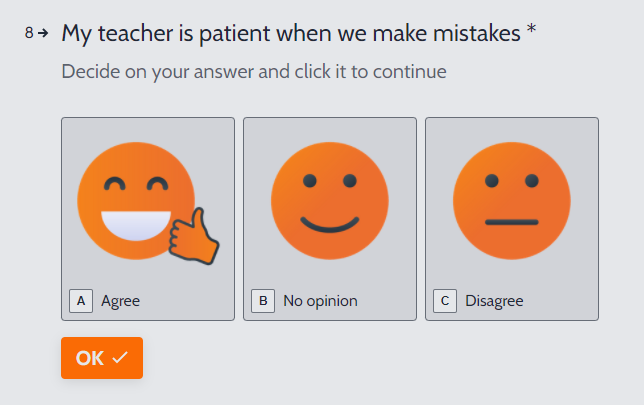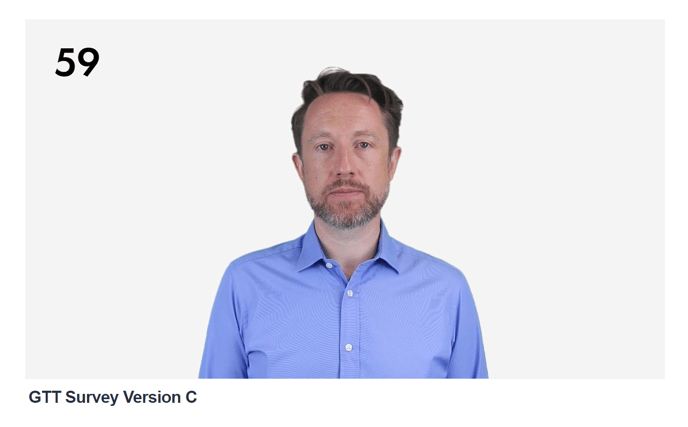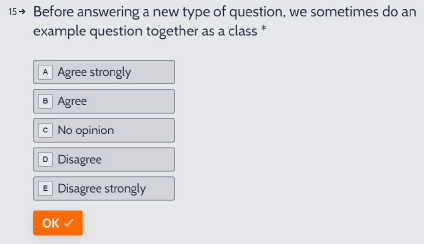Which student survey version should I use?
You can use student surveys to build your GTT profile and inform your choice of which Element to explore. There are different versions aimed at students at different reading levels.
You can use student surveys to generate your GTT profile. After you have set up your classes, you can start using the feedback tools.
When you set up a student survey, you will have an option of which version you would like to use. Currently, there are four options, each targeted at a different reading age ranges:
- Version B: Suggested for students with a reading age of 5-7; questions are both text and video.
- Version C: Suggested for students with a reading age of 8-14; questions are both text and video.
- Version D: Suggested for students with a reading age of 11-16; questions are text only.
- Version E: Suggested for students in a post-16 context; questions are text only.
Although the different versions are designed with an age range in mind, you can use a version for older and younger students. For example, you may decide to use Version B with a Year 4 group (age 8-9) with relatively low literacy or with additional needs. Similarly, even an older group of students in a special school may find Version B more accessible. The students taking the survey will not see the suggested age ranges.
All survey versions use multiple-choice responses to gauge students’ perceptions of what happens in their class. In all versions, students’ responses are recorded online and each student will need their own device.
The results from the student surveys are always aggregated — you will not know how individual students responded. Similarly, school Coordinators and MAT administrator accounts can see aggregated school-level feedback once 5 or more teachers have completed the same type and version of survey. However, individual feedback is confidential to the teacher and can only be accessed through your own, private account.
Survey types and versions
Three types of student survey are available in the GTT, depending on whether you want to focus on a particular Element or Dimension of Great Teaching, or if you want to look at your teaching practice across all areas. You can find out more about the different types of surveys here. It is worth noting that not all survey types are available in every version, as shown in the table below.

In terms of the Model for Great Teaching survey, Version B is shorter than Versions C, D and E. It only includes 25 questions covering Dimensions 2, 3, and 4. As a result, it can’t provide Element-level surveys; it will only return an overall profile for the three Dimensions. Students have a choice of three multiple-choice responses, which use smiley face icons and text (yes/maybe/no).
Versions C, D and E are more detailed than Version B. There are a little over 100 questions that cover the various Elements and Dimensions; there are also shorter versions that focus just on a specific Element. Students have a choice of five multiple-choice text responses (agree strongly to disagree strongly).
Versions B and C have accompanying videos to increase the accessibility of the survey and the questions. A teacher can play the video for the whole class at once, or each student can individually watch and listen on their own device.
Version C can be split in half, for example to be taken over two days.
Timings
For the full Model for Great Teaching survey, we advise allocating 20 minutes for Version B, although it may well not take that long (the accompanying video is 10 minutes, if uninterrupted). For Version C, if this is teacher-led, we advise allocating 30 minutes, compared to 45 minutes if the students work through it independently. We advise allocating 30 minutes for Version D and 25 minutes for Version E.
We would advise you allocate 15 to 20 minutes for Dimension-level surveys. Element-level surveys should be easily completable in 15 minutes.
Sample survey items
Version B

Version C video

"59: Class rules seem to change from day to day. What was allowed one day is not the next."
Version C, D and E text

